By definition, exempt reporting advisers (“ERA”) are investment advisers that are not required to register as an adviser with the Securities and Exchange Commission (“SEC”) or state regulators, but must still pay fees and report public information via the IARD/FINRA system. As a partner to ERA’s and registered investment adviser (“RIA”) firm’s, we are often asked if and when an ERA would need to transition to the status of an RIA firm. In this blog post, we cover the conditions which would require an ERA to register as a RIA, as well the steps to take to become registered with the state or federal regulators.
Federally, the two exemptions that advisers can use to claim ERA status are (i) the Private Fund Adviser Exemption or (ii) the Venture Capital Fund Adviser Exemption.
When does an ERA need to register as an RIA?
If either exemption will become inapplicable because the adviser will be taking on separately managed accounts (SMAs), in addition to the current funds, then the investment adviser must promptly register with the appropriate regulator (SEC or state) prior to taking on its first SMA.
If an ERA reports in its annual Form ADV amendment that it has $150M or more of private fund AUM or has agreed to serve a client that is not a private fund, the adviser is no longer eligible for the private fund adviser exemption.
Once an investment adviser becomes ineligible for the exemption provided by the Dodd Frank Act, the adviser must comply with all applicable laws and rules requiring registration with the SEC or notice filing within 90 days of ineligibility of the exemption.
The adviser may continue to act as a private fund adviser, consistent with the requirements of rule 203(m)-1 during the 90-day transition period. Please be aware, the 90-day transition period is not available to advisers that have failed to comply with all SEC reporting requirements applicable to an ERA, or that have accepted a client that is not a private fund.
What steps does the ERA need to take next?
Since the firm will now be recognized as an RIA, it will be subject to the typical rules and requirements of an RIA such as the Code of Ethics, compliance manual and ADV 2 brochure filing requirements. We would like to stress that there are significant differences in rules and requirements between an ERA and RIA. For example, an ERA is not required to prepare the ADV Part 2A brochure, while an RIA is required to complete and file these forms. Learn more about the compliance requirements of an RIA firm here.
As part of the transition of status, the firm will need to submit a final report as an exempt reporting adviser in FINRA’s IARD system, and apply for registration with the appropriate regulator (SEC or state).
